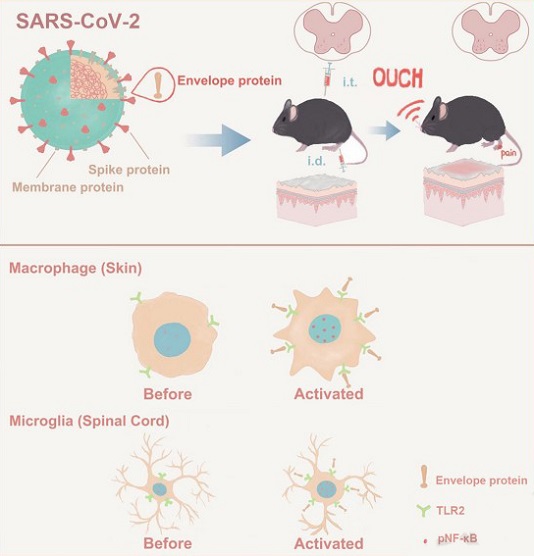Nikhil Prasad Fact checked by:Thailand Medical News Team Sep 25, 2024 1 year, 3 months, 5 days, 7 hours, 58 minutes ago
Medical News: Researchers from several prominent institutions in China have uncovered a new mechanism behind the persistent pain experienced by many people who suffer from long COVID-19. This research could pave the way for better treatments for these lingering symptoms, which have become a major concern in the wake of the COVID-19 pandemic.
 Graphical Abstract. New insights reveal how COVID-19 causes persistent pain and inflammation
Understanding the Pain Behind COVID-19
Graphical Abstract. New insights reveal how COVID-19 causes persistent pain and inflammation
Understanding the Pain Behind COVID-19
As the world continues to recover from the COVID-19 pandemic, many people are left struggling with long-term symptoms, even after the initial infection has cleared. One of the most common complaints is chronic pain, which can affect various parts of the body. This
Medical News report discusses the study that has identified one of the key factors contributing to this ongoing pain: the envelope protein of the SARS-CoV-2 virus.
Researchers from the State Key Laboratory of Common Mechanism Research for Major Diseases-China, the Department of Neurosurgery at Xuanwu Hospital-China, and the Chinese Institute for Brain Research, among other institutions, have been working to understand how the SARS-CoV-2 virus, which causes COVID-19, leads to these prolonged symptoms. They have discovered that the virus's envelope protein (known as S2E) plays a direct role in causing pain by triggering inflammation in the body’s nervous system.
How the Virus Affects the Nervous System
The study focused on three proteins found on the surface of the SARS-CoV-2 virus: the spike protein (S2S), the membrane protein (S2M), and the envelope protein (S2E). While the spike protein is best known for helping the virus enter human cells, the envelope protein appears to have a different, more harmful effect on the nervous system.
The researchers found that the S2E protein was present in parts of the nervous system responsible for sensing pain, including the spinal cord and certain nerve clusters in COVID-19 patients. This finding is significant because it suggests that the virus directly impacts the body’s pain pathways, which helps explain why so many people experience pain even after their respiratory symptoms have cleared.
Experimenting With the Envelope Protein
In laboratory experiments, researchers injected mice with the S2E protein to see how it affected their pain response. The results were clear: the mice showed signs of increased sensitivity to pain, such as withdrawing their paws from even slight touches and heat. This pain response was not observed when the mice were injected with the other viral proteins (S2S and S2M), suggesting that the envelope protein is uniquely responsible for these pain symptoms.
Further experiments revealed that the S2E protein triggers an inflammatory response in the body by activating certain immune cells, specifically macrophages and microglia, which are found in the nervous system. These cells, once activated, release chemicals that lead to inflammation and
pain.
A Potential Treatment Target
One of the most promising findings from this study is the identification of a specific immune receptor, known as Toll-like receptor 2 (TLR2), which the S2E protein uses to trigger this inflammatory response. When researchers blocked this receptor in mice, they found that the animals experienced less pain, suggesting that targeting TLR2 could be a potential treatment for COVID-related pain.
This discovery offers hope for the development of new treatments that could help people suffering from long COVID-19. By focusing on this specific pathway, future medications could reduce the inflammation caused by the virus and alleviate the chronic pain that so many people are experiencing.
The Bigger Picture: Why This Matters
Pain is a complex symptom that can be caused by many different factors, but what makes COVID-19 pain so challenging is its persistence. Even after the virus is no longer detectable in the body, the immune system may continue to cause inflammation in response to the virus’s lingering proteins. This chronic inflammation is what drives the ongoing pain experienced by many people with long COVID.
This study sheds new light on how the SARS-CoV-2 virus affects the body beyond its initial respiratory symptoms. By showing that the virus can invade the nervous system and directly cause pain, researchers are one step closer to understanding the full impact of COVID-19 on the human body.
What’s Next for Research?
While this study has provided valuable insights into how COVID-19 causes pain, there is still much more to learn. For one, researchers are interested in exploring whether these findings apply to all strains of the virus, including new variants. The envelope protein used in this study came from the Omicron variant, which has been the dominant strain in recent months, but it’s possible that other variants may behave differently.
Moreover, while the findings from this study are based on laboratory experiments in mice, researchers will need to conduct more studies in humans to confirm that the same mechanisms are at work. If they are, then targeting the envelope protein and the TLR2 receptor could become an important part of treating long COVID symptoms.
Conclusions
In summary, this new research highlights the role of the SARS-CoV-2 envelope protein in causing pain through inflammation of the nervous system. By interacting with immune cells and triggering the release of inflammatory chemicals, the virus creates long-lasting pain that can persist even after the infection is gone. This discovery not only explains why so many people experience chronic pain after recovering from COVID-19 but also offers a new avenue for treatment. Targeting the TLR2 receptor, which plays a key role in this process, could be a promising strategy for reducing COVID-related pain and improving the quality of life for millions of people worldwide.
The study findings were published in the peer-reviewed journal: iScience.
https://www.sciencedirect.com/science/article/pii/S2589004224022521
For the latest COVID-19 News, keep on logging to Thailand
Medical News.
Read Also:
https://www.thailandmedical.news/news/study-finds-that-42-6-percent-of-those-infected-with-covid-19-exhibit-persistent-musculoskeletal-pain
https://www.thailandmedical.news/news/covid-19-s-unexpected-impact-rising-orofacial-pain-among-infected-individuals
